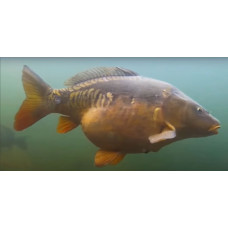Large omnivorous fish with a thick, moderately elongated body covered with large, smooth, tightly seated scales. The sides are golden in color, the back is darkish. Coloration may vary depending on the habitat. There is a dark spot at the base of each scale, the edge of the scales is bordered by a black dotted stripe. Scales in lateral line 32-41. Specimens weighing over 40 kg and more than a meter long are rare. The head is large. The mouth is semi-lower, extending. The lips are well developed. There are two pairs of well-developed short whiskers on the upper lip. The dorsal fin is long with a small notch, the anal fin is short. The dorsal and anal fins have a serrated barbed ray ("saw"). Within the domesticated form there are mirror, or royal, carp (Cyprinus rex cyprinorum) with very few rows of extremely large scales and naked rest of the body, as well as leathery carp (Surrinus nudus) with completely bare skin.
Inhabits the basins of the Azov, Black, Caspian, and Aral seas, Lake Kapchagai, and the Amur River. Acclimatized in many water bodies of Central Asia, Western and Central Siberia and Kamchatka. There are two forms of the species - resident and semi-residential. The former permanently inhabits one water body, the latter - in desalinated areas of the sea or lakes, with migration to rivers for spawning. It inhabits quiet, standing or slowly flowing waters with hard clay, slightly silted bottom. In the lower reaches of rivers flowing into the Black Sea, it is found in brackish waters.
It feeds in places rich in plant and animal food. In spring and early summer, it mainly feeds on young shoots of reed, cattail, mullein, pondweed and other aquatic plants, eagerly eats eggs of early spawning fish and frogs. In summer, the diet changes somewhat - leaves of aquatic plants, although included in the menu, recede into the background. Now the basis of the diet is made up of aquatic insects, worms, small snails, goblets, molting crayfish, small leeches, etc. It also eagerly eats mollusks (dreissen, small pearlfish, coils, pondweed). In the fall, it completely gives up plants and switches to small aquatic insects and invertebrates. It feeds almost without interruption, as it belongs to gastric-free fish. Fry two weeks old feed on mosquito larvae, and then benthic organisms living in the mud. For the winter it burrows into deep holes, its body is covered with a thick layer of mucus, its breathing slows down and it stops feeding. With the onset of spring floods, it leaves the pits and enters the floodplain.
Spawning in fresh and brackish water, in the coastal zone among vegetation. Producers approach spawning grounds, where they accumulate at depths of 1.5-2 m among thickets of plants, 3-4 weeks before spawning when water warms above 10 °C. Spawns at a temperature of 18-20 ° C. Spawning - group spawning. Each group consists, as a rule, of a female and two to five males accompanying her, but often not more than three. Spawning proceeds violently. Accompanied by a lot of noise, frequent splashes. Spawning itself often begins after sunset, can last all night until 9-10 am. Fecundity of about 1.5 million eggs. Spawning in batches, from April through July. Fertilized eggs mature in 3-4 days. Spawning grounds are mainly the shallowest freshly flooded coastal areas up to 40-50 cm deep among thickets of coastal vegetation. In river floodplains, spawning grounds are sodded areas with developed meadow vegetation. In reservoirs it lays eggs on both hard plants and filamentous algae, as there are usually no sodded spawning grounds in reservoirs. Due to the lack of spawning areas, the same spawning grounds are used repeatedly.
Sexual maturity in the 2nd-5th year of life. Males reach sexual maturity at the age of about three years with a body length of 29 to 36 cm; females - at three to five years with a length of 34-45 cm. Lives up to 30-35 years, but growth stops at 7-8 years of age, i.e. the main weight gain occurs in the first quarter of life.
The carp's danger signal is a series of crackles emitted by the leader who has detected an enemy.
Eurasian carp
Tags: eurasian carp



